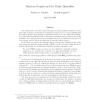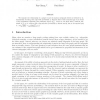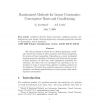1806 search results - page 37 / 362 » Randomness and halting probabilities |
STOC
2009
ACM
14 years 8 months ago
2009
ACM
The classical zero-one law for first-order logic on random graphs says that for every first-order property in the theory of graphs and every p (0, 1), the probability that the r...
IM
2007
13 years 7 months ago
2007
We examine the relationship of a graph G and its random subgraphs which are defined by independently choosing each edge with probability p. Suppose that G has a spectral gap λ (...
COMBINATORICS
2004
13 years 7 months ago
2004
Consider random regular graphs of order n and degree d = d(n) 3. Let g = g(n) 3 satisfy (d-1)2g-1 = o(n). Then the number of cycles of lengths up to g have a distribution simila...
STOC
2002
ACM
14 years 7 months ago
2002
ACM
Two infinite walks on the same finite graph are called compatible if it is possible to introduce delays into them in such a way that they never collide. Years ago, Peter Winkler a...
CORR
2008
Springer
13 years 7 months ago
2008
Springer
We study randomized variants of two classical algorithms: coordinate descent for systems of linear equations and iterated projections for systems of linear inequalities. Expanding...



